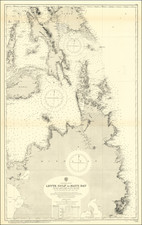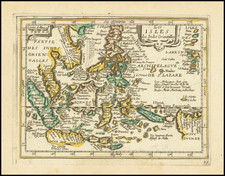Striking and Detailed Secret Japanese World War II Map of the Philippines
This rare find, a map of the Philippines by the Land Survey Department (Rikuchi Sokuryō-bu) of the General Staff Office (Sanbō-honbu) of the Imperial Japanese Army, shows the archipelago in outstanding detail. The map was most likely part of the materials used to plan the Japanese assault on the Philippines that began in December 1941.
The map was restricted to the exclusive use of the General Staff Office, as indicated by a note in the top right corner. It is dated August 1941, or Shōwa 16, to use the imperial date format adopted by Japan in 1926. However, Japan had begun to map Luzon at a high resolution from as early as 1938, revealing their expansionary plans.
The aerial map was one of a set of four; a key to this “Southern Map” series—this is number four in the series—are below the legend in the top left corner. Next to this is another key which divides the present map into six numbered sections. The sources for each of these sections are listed below that key.
The legend in the top left corner shares a complex symbology that would tell the viewer a plethora of information about the Philippines. The size of settlements, roads, air routes, radio beacons, airports, volcanoes, ports, radio towers, broadcasting stations, lighthouses, and other types of infrastructure are all labeled. The dotted lines connecting the islands and cities via the waterways are shipping lanes, while the small lines of cross-and-dots are international boundaries. Additionally, the color bar indicates the topography of the islands, which varies greatly.
The map is nothing if not exacting in its detail and design. A separate scale is included for each line of latitude, acknowledging the subtle changes in distances between meridians as one travels north and south. In addition to the Mercator projection graticule of latitude and longitude, there are also pink curving lines that overlay the map. These are lines of magnetic variation, further allowing military planners to minutely understand the Philippines archipelago.
The date, intended military audience, restricted distribution, and nature of the information contained suggests that the map was one of the documents used to plan the Japanese invasion of the Philippines. As a topographical map, it would have aided in planning the inland phases of the invasion, after the Japanese troops had initially landed.
Japanese expansion and the Philippines
Together, the Southern Map series of which this example is a part shows the majority of maritime Southeast Asia, which Japan wished to add to its empire during World War II. Japan began this wave of its expansion in 1931, when it invaded Manchuria and, in 1937, China. After a summer of escalation, in September 1940, Japanese troops entered French Indochina, forcing the French colonial officials to recognize their presence. In the same month, Japan entered into the Tripartite Pact, joining the Axis Powers of Germany and Italy.
By July 1941, just before this map was made, the Japanese controlled the entirety of French Indochina. They therefore controlled much of East Asia and were looking south to the natural resources of the island nations and colonies such as the Philippines and the Dutch East Indies. This map shows as much, as it was made in August 1941. Additionally, this was an area with both a British and a US presence, which would allow the Japanese to lash out against those who had imposed sanctions upon them.
On December 8, 1941, as part of the larger attack which included the aerial assault on Pearl Harbor in Hawai’i, veteran Japanese troops invaded northern Luzon. They would eventually land troops around the island in waves from Taiwan, Palau, and the Ryukyu Islands. Then they began an overland march toward Manila from both the north and the south of the island. This map would have helped the Japanese to plan this stage of their plans.
US troops stationed on Luzon had their defenses overrun, but they had time to retreat to the Bataan Peninsula, where they set up a final line of defense by early January 1942. The Japanese attacked the combined American and Filipino forces on Bataan for the next three months. However, the Allied forces were outnumbered, and eventually General MacArthur, the commander of US forces, had to leave the Philippines. In April 1942, Bataan was overrun; many of those imprisoned were then forced on the infamous Bataan Death March. By early May, the Japanese had defeated the remaining Allied troops on the island of Corregidor.
The Japanese therefore controlled most of the area shown on this map by May 1942. As for the other maps in the Southern series, the Japanese invaded the Dutch East Indies in early January 1942. They quickly overwhelmed the Dutch forces, who surrendered on March 8. The Japanese then controlled all the area shown on the four-map series of which this map is a part.
Japanese military mapping to WWII
The Japanese developed thousands of maps, printed in millions of copies, in World War II. The main service who produced these was the Army Land Survey Department, who also made this map. Maps showing the “outer lands,” or lands outside of Japan, were called gaihōzu. Many of these maps were considered to be military secrets and the Japanese spread them across many libraries and institutions, so that they would not all be lost in a single nuclear attack or bombing raid.
Japanese military surveyors had begun to develop their own maps in the late-nineteenth century. The Army Land Survey Department was founded in 1888 to survey and map Japan and the overseas territories in which it was interested. Survey teams were deployed with troops in Korea and China in the 1890s and into the early-twentieth century. The Japanese also used maps they captured from enemies to improve their own cartography, for example from Russia during and after the Russo-Japanese War.
Interestingly, while World War II resulted in the standardization of map styles in Allied countries, in Japan the maps produced were wildly diverse. This is because each series of map was meant for a different purpose and its makers therefore varied the information and design to fit that need. This series is just one example of this diversity.
After World War II, the Japanese army and navy were disbanded. The Army Land Survey Department was decommissioned as well, transforming into a civilian agency.
Rarity
Most of the maps made by the Army Land Survey Department were destroyed as Japanese troops retreated across the Pacific in 1945. Some were captured by Allied troops and made their way to institutional collections, such as Stanford University’s library. Others were protected by the Japanese cartographers who made them, and some are still in the collection of Japanese universities, like Tohoku University Library.
However, the majority of the Army Land Survey Department’s output is now lost. They rarely appear on the market and we are unaware of another example of this present map.
The Army Land Survey Department was the mapping body of the Japanese Army. Founded in 1888, it was responsible for the mapping of Japan and overseas territories. Influenced especially by French and Prussian mapping practices, the Department mapped land from Mongolia and the Arctic to Australia and Polynesia. It was modified into a civilian agency at the close of WWII, due to the dissolution of the Japanese Armed Forces.










![Les Isles Philippines Molucques et de La Sonde [Japan inset]](https://storage.googleapis.com/raremaps/img/small/69697.jpg)
![Il Disegno Della Terza Parte Dell' Asia [Gastaldi's Wall Map of SE Asia with extra panels!]](https://storage.googleapis.com/raremaps/img/small/30554hbp.jpg)


![[ China Sea / Luzon / Hong Kong / Canton / Formosa ] Bogt Toncqin (VOC - Dutch East India Chart by Its Chief Map Maker in Batavia)](https://storage.googleapis.com/raremaps/img/small/64690.jpg)